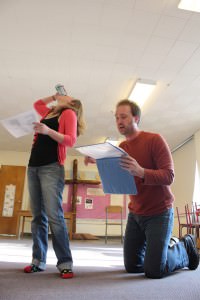Last week, co-Artistic Director Mike Boynton gave you an overview of Pallas Theatre Collective’s mission and history. This week, we’d like to offer you an inside look at the creation of our newest project, The Tempest: Such Stuff as Dreams are Made on, directed by co-Artistic Director Tracey Elaine Chessum, coming this January (Pallastheatre.org/tickets)! I have a love/hate relationship with The Tempest.

On one hand, I find Shakespeare’s story of Prospero’s struggle to regain his dukedom an exciting and challenging piece of work for a director. The central conflict of The Tempest, much like Hamlet, is primarily internal, as Prospero spends much of the play using his supreme intellect to analyze his own objectives and decide on a course of action and then forcing Ariel and Caliban to do the “dirty work.” It reminds me of many of the totalitarian figures we see on the news today, both around the world and in our own country. It paints a picture of a mastermind – one who makes decisions about life and death, placement in society, and the value of ‘different’ human beings – while never having to carry out his own plans.
On the other hand, The Tempest’s difficult language (even by Shakespearean standards), its structural nuances, and its plethora of feminine endings (how we learned to memorize Shakespeare just has to go out the window!), does not make it the easiest show to conquer. And, let’s not forget the character of Prospero. While I am enthralled by Prospero’s intellect, manipulation and calculation, when one truly examines his actions, Prospero is in actuality a rather distasteful character. I find him problematic as the largely un-challenged male manipulator, misogynist and patriarchal diva, as these are not archetypes that I wish to remain unchallenged on my stage.
Volumes of scholarship have been dedicated to the themes of The Tempest and many focus on “doubleness” – the seemingly dual nature of many of the characters. Are these characters monsters or heroes? For example, is Caliban, the islander, a monster as Prospero claims; or is he a hero in his struggle to stand up to Prospero as ‘colonizer’? Is Prospero a monster for his treatment of Caliban (and Antonio for that matter), or is he a heroic overcomer, who has waited patiently for wrongs to be righted? These are the questions I wrestled with when I sat down with The Tempest: were these characters monsters or heroes, or both? In its 400+ year production history, have come to learn that the answer to this question is predicated on viewpoint: from which viewpoint is the audience viewing the work (i.e. colonial/post-colonial, etc.)? From which character’s viewpoint is the story being told? To shift both the audience’s and character’s viewpoint changes the story is a distinct way.

Like Aime Césaire’s A Tempest (which adapts Shakespeare’s plot to tell the story from Caliban’s point of view), I wanted to explore, in pseudo-Bogartian fashion, the different characters’ viewpoints in the piece. Obviously, this isn’t new in the theatrical world, but is still a useful tool by which to explore and create new stories and visions from our archetypal literature. I knew I had no desire to tell it from Prospero’s point of view, nor Caliban’s. After 10+ years of graduate school, I am tired of the perfectly valid, but at times over-used, classic post-colonialist interpretation of The Tempest – especially after reading volumes of student essays on the topic – so I also wanted to steer clear of this interpretation.
I began asking questions such as: Are these characters more monster or hero when they are played by a different gender? For example, how does the relationship between Stephano and Caliban change when Stephano is played as a woman? Does a particular character display more heroic qualities when told from an opposing point of view? As I asked these questions, I found myself more and more drawn to the villain in the shadows, to Prospero’s brother, Antonio. I remember reading The Tempest in high school and thinking that Antonio never felt “bad” enough in the text or on the stage to be the cause of all this drama. Antonio’s work is done before the show begins, making him the villain who is never really able to engage his archetypal ‘other.’ This leaves Caliban to serve in this role, engaging Prospero and providing a secondary conflict. Pallas’s The Tempest: Such Stuff as In essence, Caliban’s secondary conflict often usurps Prospero’s primary conflict with his brother, and I wanted to bring this more into balance.
Pallas’s The Tempest: Such Stuff as Dreams are Made on, therefore, tells the story from Antonio’s point of view – as the heightened Freudian dream of a guilt-ridden man. Our adaptation not only allows Antonio to illuminate the motivation behind his overthrow of (a female) Prospero – the sister who “stole” the throne from him by virtue of being born first (how timely the change of the primogeniture laws has been) – but explores Antonio’s anxieties about his subjugation in Prospero’s family and dukedom. This Antonio, in the anxiety of his dreams, sees himself as a Caliban to Prospero – a man who is colonized for the talents he brings to Prospero’s royal family, but yearns for his own freedom and recognition, and acts on it. Playing with gender, Sebastian, usually Antonio’s daft henchman, is now his beautiful wife – scheming to put her & Antonio’s son, Ariel, on the throne. What emerges is a tale of two siblings, both infinitely intelligent, ever calculating their next move in an effort to achieve dominance and outwit the other.

As Laura Rocklyn, our fabulous dramaturg, and I began working on the script, she ran with this theme of calculated scheming and focused my attention on the chessboard. While Shakespeare usually refrained from giving explicit stage directions in the text, The Tempest gives one of the most specific stage directions in the Shakespearean canon: “Prospero discovers Ferdinand and Miranda playing at chess.” Laura began to frame Miranda and Ferdinand’s chessboard as a metaphor not only for our manipulation of viewpoint and gender to illustrate how perspective often distorts the facts of a situation, but also for the strategic way in which Antonio and Prospero calculate their next moves in their plans for dominance. Therefore, all the characters in our show are pieces on the chessboard – governed by their own rules of play and distinctive movements. In essence, each character displays their own viewpoint clearly, as the game being played throughout the show looks very different to Caliban, the Pawn, than it does to Prospero, the King.
Part of my love/hate relationship with The Tempest has been that it is so tied to particular interpretations. I’m sure that many people coming to our production will come with a set of expectations about what this show “should” be about – and will be thoroughly confused when Caliban emerges as a projection of a very angry Antonio (and a very pale Antonio at that!). However, perhaps the subjection in The Tempest, the making of monsters and heroes, is not only about race, but also family relationships and societal expectations. Perhaps The Tempest, and particularly Antonio’s Tempest, can show us that, whether we win or lose, we must wrestle with the beast within if we are to have any hope of overcoming the expectations that subjugate us. To do nothing – to stay hidden in the shadows – only perpetuates a false dream. And, as Laura puts it so poignantly, “We hope that you will ask yourselves some questions about how you perceive the world around you, and take a moment to ponder what the differences are between your waking view of the world and the view of the world that is revealed in your dreams.”
Stay tuned for Part 3 next week as we take an an inside look at designs for The Tempest and interviews with the designers! 
LINK:
Pallas Theatre Collective’s website.




